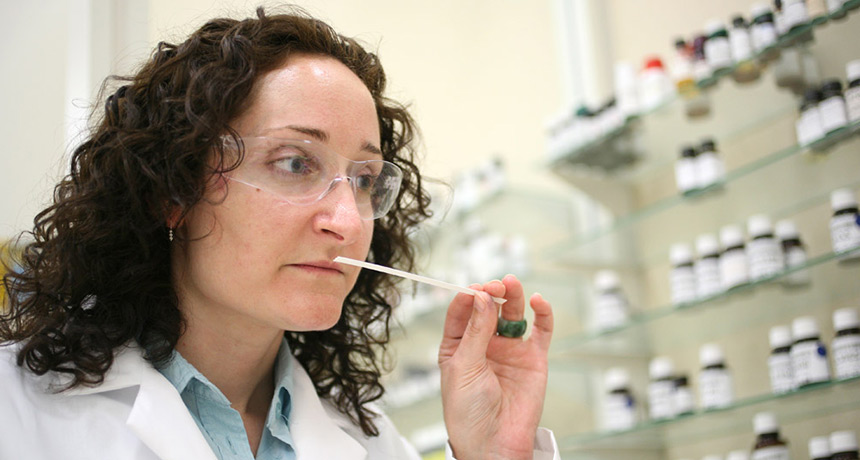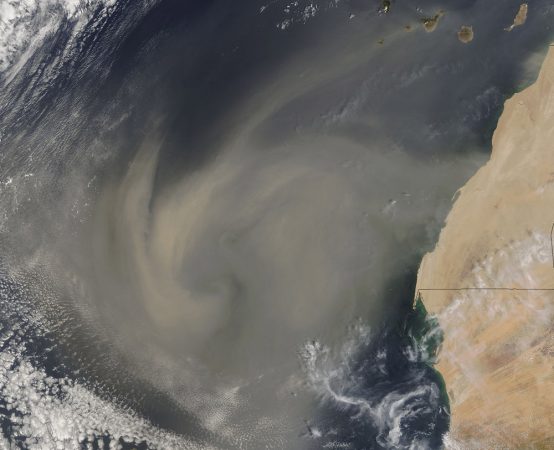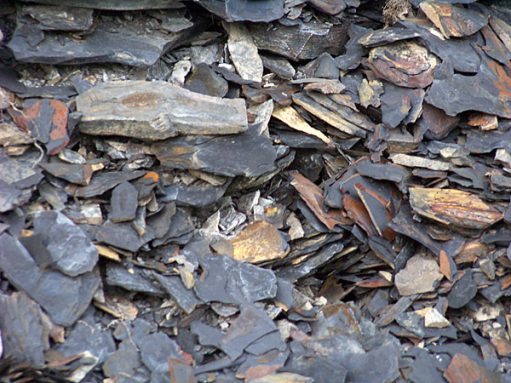Cool Jobs: People with a taste for chemistry
Chemists contribute to food flavorings, fuel extraction and everything in between

Chemist Dana Sanza smells a chemical concoction to determine if it has the right “fruity note” in her lab at FONA International in Geneva, Illinois.
Jimi Allen Productions
People have always looked to chemistry as a means to improve lives. Some 500 to 1,500 years ago, European chemists of the Middle Ages attempted to unlock the key to living forever. Some of these scientists, then known as alchemists, also tried to find a single cure for all diseases and a way to transform cheap metals into gold.
Today chemistry can be linked to the creation of just about every product in society — from sneakers and electronics to medicines and food flavorings. And chemistry is being used to tackle our most pressing problems, such as climate change and the increasing demand for energy to keep cars and trucks running and laptops humming.
Here are a trio of people working on such developments and a glimpse of what pulled them into such pursuits.
Tinkering with tastes
Chocolate-covered peanuts, s’mores, candy bars — let’s admit it; most people go crazy for chocolate. So imagine a job that requires you to taste chocolate flavors all day.
Chemist Dana Sanza does just that. She works for FONA International, a company that manufactures flavors out of natural and synthesized (or human-made) materials. Its products provide the sweet, spicy or other seasonings that give foods and beverages their distinguishing tastes. Sanza spends her days sampling and then tweaking flavors in an effort to create the exact tastes that her company’s clients desire.
“We eat all day,” she says. “When I graduated from college and first started working at a flavor house, I gained 15 pounds, because we screen everything before we put it into a product.”
As a girl, Sanza sometimes accompanied her dad to his job at McCormick, a company that produces seasonings and flavorings. There she was first exposed to food spices and flavor extracts (flavorings made by removing and isolating certain ingredients of a complex plant or animal product). “I was always fascinated with the flavor side of the business,” she says.
The companies that make food products often ask chemists like Sanza to recreate a specific taste. It may be a flavor that mimics one found in nature, such as chocolate from a cocoa bean. Flavor chemists, also known as flavorists, use chemistry to break the bean down into its many different chemicals and then focus on those that contribute most to the food’s characteristic flavor.
Once flavorists have identified the combination of chemicals responsible for a flavor, they can buy pure forms of those chemicals and combine them in the lab. They may then add additional chemicals (such as ethyl butyrate and acetaldehyde) to enhance aromas. The goal: to re-create the taste that the food makers seek, such as the flavor of a popular chocolate drink, perhaps using fewer ingredients than the natural product. Reproducing certain flavors — coffee, for example — can require hundreds of chemicals.
Often, companies seek to make these synthetic flavors because the original source — such as cocoa beans — may be too expensive or rare. Or the natural source materials may come from areas of the world that are politically unstable, making it too risky to harvest and difficult for food companies to reliably acquire.
“Making chocolate treats straight from real cocoa beans is expensive,” Sanza explains. One reason for this is that it takes many people to harvest cocoa beans. The beans grow in pods that are handpicked from the tree. Then the beans are removed from the pods. Some of her concoctions can make it easier for food manufacturers to make chocolate-flavored foods at a price more people can afford.
Sanza didn’t always dream of being a flavorist. She studied chemistry and biology in college because she thought she wanted to help find a cure for cancer. But somewhere along the line, Sanza became interested in food science. She found she needed analytical chemistry courses to learn how to use complex instruments that can separate a complex compound or group of them into individual chemical components.
Flavorists also participate in a seven-year-long apprenticeship to be certified by the Society of Flavor Chemists. Flavorists-in-training start out working in a flavor company, mixing together chemicals, solvents (a substance that can dissolve another substance) and other materials to create a flavor. Even as trainees, flavorists taste their projects to see if they are getting them just right. Although Sanza admits that she is a chocoholic, she says her job includes tasting many other flavors as well.
This is a great career if you are creative and drawn to science, she explains, because it is really both a science and an art. And don’t worry if math is not your favorite subject, she adds. “I am not great at math,” she notes, even though it is something that she uses every day on the job. But, she says, if it’s an essential tool for what you want to do, “you can always learn it.”
Braving desert dust
Some windstorms whip up so much dust, sand and dirt that they create a dense haze that rises high overhead. These dust clouds can be so severe that they make it hard to see your own hand in front of your face. Atreyee Bhattacharya, a recent Harvard University graduate, was so excited by these desert phenomena that she decided to study them and how they might affect weather.
Her work focuses on how warming temperatures due to climate change might interfere with rainfall patterns. As conditions dry a landscape, soil will dry out, allowing winds to fling it skyward. She is especially interested in effects on desert regions in Africa, China and the southwestern United States.

In the laboratory, Bhattacharya uses analytical chemistry to probe residues that became buried by dust storms 400 to 500 years ago. These studies let her combine her passions for Earth’s history and current events.
Even in middle school, Bhattacharya, now 30, loved chemistry. But, encouraged by her father, she initially studied geology. “My dad was a famous geologist in India where I grew up and I was a big fan of National Geographic magazine,” she says. Her dad was fascinated by the history of Earth and suggested she might like it too.
After college, Bhattacharya says she “wanted to get into a career in which I could use science as a tool to study issues that are affecting people today.” So she began focusing on the planet’s changing climate.
She started by compiling a 300-year-long record of dust storms. Her data suggested that the amount of dust in today’s atmosphere is influenced by the amount of rain that fell tens — and possibly hundreds — of years ago.
Using advanced chemistry techniques, she searched for clues to the history of desert dust in the atmosphere. She found evidence by measuring the amount of dust caught in old corals living in ocean waters near the desert.

Corals have annual growth bands similar to tree rings. Each band marks a year of the coral’s life. And a coral’s porous structure acts like a natural sieve, collecting dust every year, Bhattacharya explains. In this way, corals are similar to instruments that can be used to estimate dust from desert regions over the past few centuries. As dust from a desert storm blows over the ocean, some falls down into the water column and becomes trapped in a coral’s skeleton.
Bhattacharya’s research now indicates that long-running drought sends clouds of dust into the atmosphere. The dust changes cloud properties in ways that can largely prevent them from raining out moisture. So the warming temperatures associated with climate change can create dry conditions that lead to drought. Such findings might provide useful planning information to help people in arid parts of the world who depend on sufficient rain for drinking water and crops.
Bhattacharya enjoys investigating the lessons about how storms’ movement of dust can affect climate. She says it “has given me a pretty exciting life.”
Finding fuel in rocks
John Zumberge always loved being outdoors. So decades ago, he started his career by scouting hillsides, looking for natural oil dribbling out of rocks or in small pools in soil. He’d hammer away at various sites, collecting rocky rubble to take back to a lab for analysis. Today, he works in a lab, analyzing the quality of fossil fuels such as oil and natural gas. These fuels form over long periods of time from the remains of living organisms and are used to power vehicles and to produce electricity.
As a petroleum geochemist, Zumberge studies the oily, flammable liquid that is the source of gasoline, kerosene and other products. He tries to understand how oil and gas at certain underground pockets moving around. This helps oil producers identify the best places to drill down and extract energy-rich fuels.
He is also a businessman: Together with a friend, Zumberge co-owns GeoMark Research, Ltd., in Houston. This company examines the quality and source of oil and gas deposits deep in the earth.
Zumberge uses high-tech tools to analyze petroleum, also known as crude oil, for chemical fossils, sometimes called biomarkers. These chemicals offer clues to the type of rock, buried far underground, in which the oil formed. The chemicals can also provide information about the oil’s quality. For example, rocky shale produces oil with low concentrations of sulfur impurities. Limestone tends to produce oil with lots of sulfur. To keep air pollution levels low, companies that produce gasoline will pay more for low-sulfur oil, Zumberge explains.

Biomarkers also indicate the path that oil took as it moved toward the surface. This information can help geologists pinpoint where to drill the next well.
As a kid, Zumberge first learned about science from his dad, who was a geology professor at the University of Michigan in Ann Arbor. Sometimes John’s father took the boy and his three siblings on field trips with the college students.
Later, when Zumberge went to college, he discovered that geochemistry classes combined two of his favorite hobbies: hiking and laboratory chemistry.
Natural oil and gas aren’t really made up of old dinosaur bones, as some of the TV ads might suggest. In fact, Zumberge explains, these fuels come from dead algae and bacteria that lived millions of years before dinosaurs existed.
Remains of those ancient algae, bacteria or other living things mixed with river or lake sediments. Eventually, those sediments were buried and compressed by the materials atop them. This compression created heat and pressure that over millions of years transformed the biological remains into oil and gas.
For years, oil companies have been drilling deep underground in search of big lakes of oil and gas. Today many companies are turning to geochemists for help in a new form of fuel exploration known as fracking, Zumberge says. In fracking, instead of drilling straight down, explorers drill horizontally through the earth and into rock. Then they break apart the rock to release the fuel underneath, so it can be pumped up to the surface through oil and gas wells.

Chemists play a role in developing all energy sources, not just petroleum and natural gas, Zumberge notes. For instance, solar energy requires people with knowledge of chemistry and physics, and the development of biofuels, such as alcohol fuels, needs chemists who also know about biology and agriculture. “But oil and gas are still going to be our major transportation fuels for a long time to come,” he says.
Power Words (adapted from the Merriam-Webster online student dictionary)
alchemy A medieval chemical science with the goals of changing less valuable metals into gold, discovering a single cure for all diseases and discovering how to live forever.
analytical chemistry A field that focuses on ways to separate materials into their parts or elements.
chemistry A science that deals with the composition, structure and properties of substances and with the changes that they go through.
chromatography Separation and detection of chemical compounds as a result of their having traveled at different rates according to their different attractions to the matter that carries them (such as a flowing liquid or gas).
climate change Long-term, significant change in the climate on Earth. It can happen naturally or in response to human activities, including the burning of fossil fuels and clearing of forests.
fossil A trace or print of the remains of a plant or animal from a past age preserved in earth or rock.
fossil fuel A fuel (as coal, oil or natural gas) that is formed in the Earth from bacteria, plant or animal remains.
geochemistry A science that deals with the chemical composition of and chemical changes in the solid material of Earth or of another celestial body (such as the moon or Mars).
sediment Material (such as stones and sand) deposited by water, wind or glaciers.
synthesis The production of a substance by the combining of simpler chemical building blocks.
This is one in a series on careers in science, technology, engineering and mathematics made possible by support from the Northrop Grumman Foundation.







